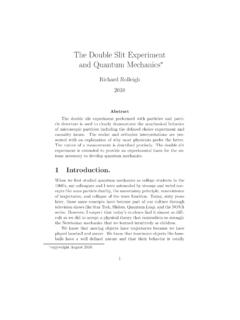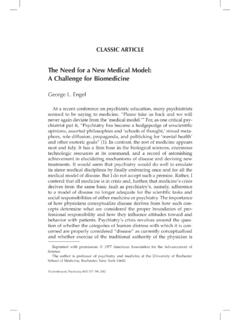Transcription of Polymorphism—A Critical Consideration in Pharmaceutical ...
1 Pharmaceutical F. Bauer]For more Author information, go to [Polymorphism A Critical Consideration in Pharmaceutical Development, Manufacturing, and StabilityWelcome to Pharmaceutical Solids. This column discusses scientific principles associated with Pharmaceutical solids useful to practitioners in validation and compliance. This column has been developed with the intention to help readers under-stands the principles associated with Pharmaceutical solids, and to be a useful resource for daily work applications. Enhanced process understanding is an important objective of the quality by design initiative. The key objective for this column: topic of Pharmaceutical solids is broad and com-plex. Its importance is unquestioned. Understanding the basic properties of Pharmaceutical solids is fun-damental to Pharmaceutical discovery, development, clinical studies, manufacturing, processing, problem investigations, and stability.
2 Unfortunately this topic often requires understanding the higher level of prin-ciples of chemistry, physics , and mathematics. These may include thermodynamics, crystallization, analyti-cal DSC, X-Ray diffraction, and other research meth-ods. Finally, the language of Pharmaceutical solids may be esoteric and considerations make discussion of pharma-ceutical solids a difficult task. This column addresses the various topics of Pharmaceutical solids with these considerations in mind. It is our challenge to present these topics in a meaningful way so that our readers will be able to understand and apply the principles discussed in their daily work first installment of Pharmaceutical Solids addresses the potential solid polymorphic forms of a drug which in turn determine many of the solid physical properties.
3 A thorough understanding of the solid state chemistry of a new drug should be a Critical component of Pharmaceutical development, and will serve throughout the entire product comments, questions, and suggestions are needed to help us fulfill our objective for this column. Suggestions for future discussion top-ics or questions to be addressed are requested. Case studies illustrating principles associated with Pharmaceutical solids submitted by readers are also most welcome. We need your help to make Pharmaceutical Solids a useful resource. Please send your comments and suggestions to column coordinator John Bauer at or to journal coordinating editor Susan Haigney at POINTS Pharmaceutical solids may be crystals, crystal solvates or hydrates, crystal desolvated solvates or dehydrated hydrates, or amorphous solids All crystal forms described can exist in different forms called polymorphs Polymorphs can have significant differences in their physical properties even though they are chemically identical.
4 Physical properties include ABOUT THE AUTHORJohn F. Bauer, , is president of Consult JB LLC Pharmaceutical Consultants. Dr. Bauer has more than 30 years Pharmaceutical industry experience, including work in solid state chemistry, analytical chemistry, stability, pharmaceutics, regulatory CMC, patents, and litigation. He may be reached at and at [Journal of Validation technology [Autumn 2008] 15 Pharmaceutical , melting point, particle size, dissolution rate, hygroscopicity, and others. Polymorphs may interconvert depending on condi-tions. Usually the metastable kinetic form converts to the stable thermodynamic form. Laboratory studies are key to determining the poten-tial of a compound to form multiple polymorphs, determining under what conditions the polymorphs are formed, what are the physical properties of each polymorph, and what is the stability of each polymorph The primary analytical method to characterize poly-morphs is x-ray diffraction.]
5 Other methods used include solid state NMR, Raman and NIR spectros-copy, and thermal methods such as DSC and TGA. Seeding is used to facilitate manufacturing of the desired polymorph Polymorph interconversions in Pharmaceutical prod-uct manufacturing have been reported for grind-ing, milling, tablet compressing, and other processes involving moisture or other solvents ICH Q6A addresses specifications for API and phar-maceutical products and includes several decision trees Awareness, knowledge, and understanding of poly-morphism are important throughout the product lifecycle. Polymorphism may impact product devel-opment, clinical studies, product manufacturing, product quality, and product stability. Change management and validation in API manufac-turing and product manufacturing should address the potential impact of formulation and process changes on API June 1998 at the Geneva International AIDS Confer-ence, ritonavir, the active ingredient in Norvir Capsules (Abbott), was identified as the key component in various protease inhibitor cocktails (combination therapies) used for the successful treatment of HIV infections.
6 This find-ing enhanced the therapeutic effectiveness of many AIDS therapies, and caused Norvir to be used in combination with many other marketed AIDS products around the world. By that time, 240 lots of the Norvir Capsules had been successfully manufactured. However, in the sum-mer of 1998, a sudden change in physical properties of ritonavir brought production to a halt and eventually led to an interruption of the supply of Norvir capsules to the millions of HIV patients who relied on the product for its therapeutic effects. The crystal form of ritonavir had unexpectedly changed. This change resulted in a solubility change for the drug, which in turn resulted in a bioavailability change and affected the therapeutic effect of the drug. The Norvir product was withdrawn from the market. An intensive research effort was undertaken to understand and solve the problem. A new capsule formu-lation was eventually introduced that overcame the physi-cal problems.
7 After implementing the new formulation, Norvir Capsules were returned to the marketplace (1).This unexpected change in physical properties had a dramatic impact on patients, the Pharmaceutical manu-facturer, and the US Food and Drug Administration. Since this crisis, FDA has become much more aware and concerned about the physical properties of drugs and the measures taken to ensure that physical properties do not change during the product shelf life. The compound that was present in the Norvir formulation before and after the sudden manufacturing problem was chemically the same. So what caused the problem, the inability to produce capsules, and the subsequent global consequences?PHYSICAL FORMS OF Pharmaceutical SOLIDS The cause of the ritonavir problem was a change in poly-morphic solid form. Most pharmaceuticals are funda-mentally organic compounds, and organic compounds can often exist in a variety of solid forms.
8 This means that although a drug will remain as the same chemical entity and have the same chemical properties of stability, reactivity, etc., it may not always act in the same way in the solid state. These differences may or may not cause a difference in pharmacological effect ( , how the drug may work in the human body such as inhibiting proteases or reducing blood pressure). In the Norvir example, the change in solid form had a great effect on solubility, which in turn reduced solids can exist in two general forms: Crystalline and non-crystalline forms. Crystalline FormsIn order to form a solid, a compound must have internal attraction between molecules that is sufficient to restrict the free movement that exists in liquids and gases, but how strong the internal attractions are can vary. There are multiple well-known solid forms that have been identified in pharmaceuticals. A crystalline solid form or crystal exists when the molecules of the drug are arranged in the solid in a three-dimensional repeating pattern or unit cell (see Figure 1).
9 Crystalline solids are usually highly stable and have a well-established solubility and dissolution rate. Most drugs are used in the crystalline Journal of Validation technology [Autumn 2008] F. BauerAmorphous SolidA second type of solid form that is non-crystalline is referred to as the amorphous form. This type of solid is randomly arranged with a high degree of disorder in the molecular arrangement. The amorphous state is usually much faster dissolving than the crystalline state, and has a variable solubility that is usually higher than the crystalline form. The amorphous form is often less stable than the crystal-line form and is usually hygroscopic ( , the amorphous form will absorb water from the atmosphere under ambient humidity conditions). In actuality, solids can exist on a continuum between amorphous and crystalline whereby they contain varying degrees of disorder the solid may be partly crystalline and partly Solvate/HydrateThe solubility that is of the most importance as far as phar-maceuticals are concerned is the aqueous solubility.
10 Some drugs can dissolve rapidly in water but then incorporate water molecules into a different solid form that has water systematically distributed within the molecular arrange-ment (see Figure 2). This solid form is known as a hydrate. Depending on the number of molecules of water incor-porated, this crystal can be a monohydrate, dihydrate, trihydrate, etc. These hydrates will have reduced solubility in water and often precipitate out of an aqueous solution of drug. It is Critical to know if a particular drug substance can form hydrates because this reduced solubility in water can also lead to reduced bioavailability and to manufactur-ing problems. Finally, it is also possible for some drugs to form solid forms analogous to hydrates but that incorporate other solvents such as ethanol or ethyl acetate into the solid rather than water. These are known as solvates. Solvates and hydrates can be very stable solid forms and may have definite benefits in regard to Desolvated Solvate/Dehydrated HydrateAlthough hydrates can have benefits in manufactur-ing, they can also present a significant problem from the standpoint of drying.








